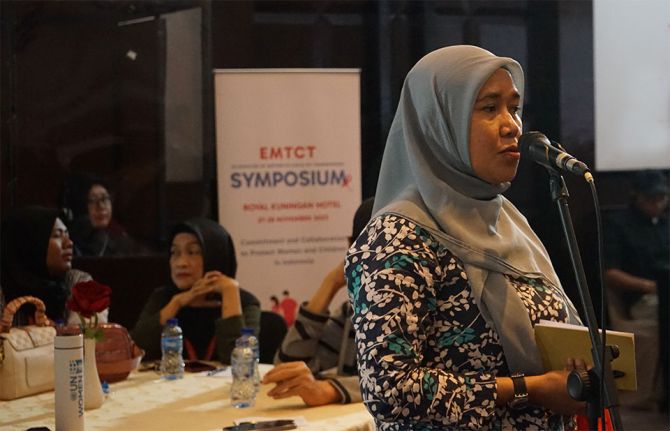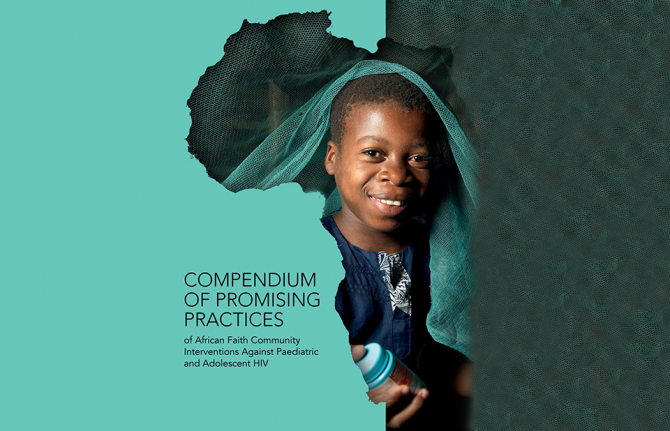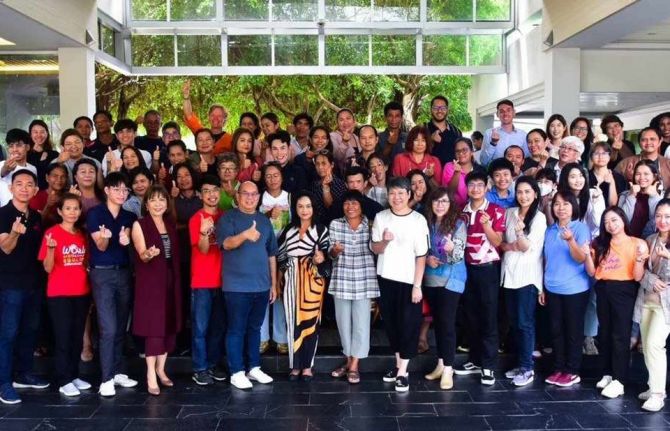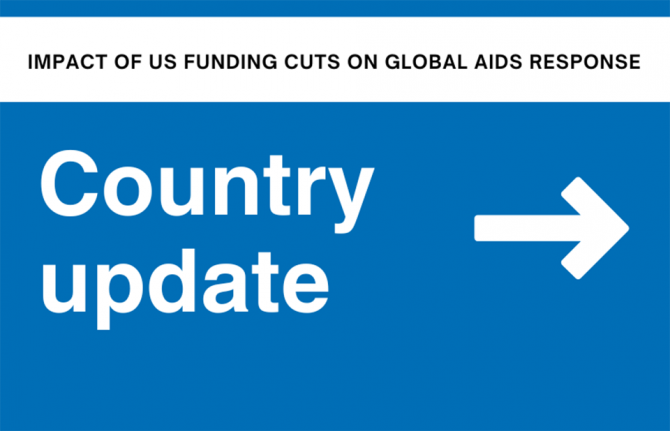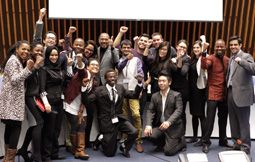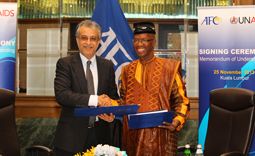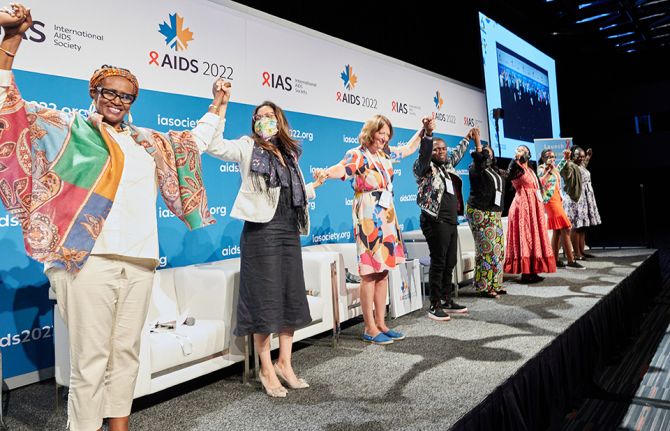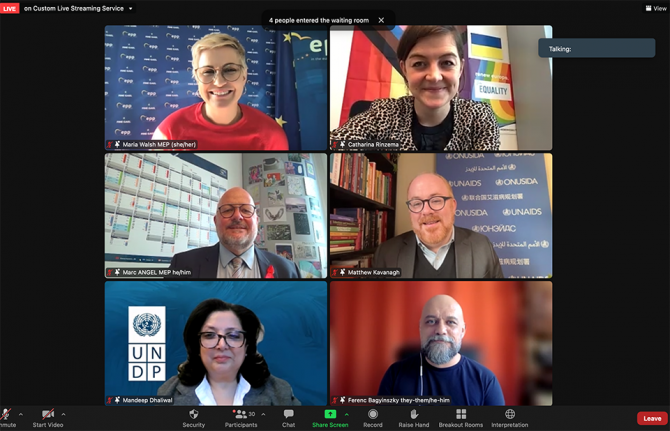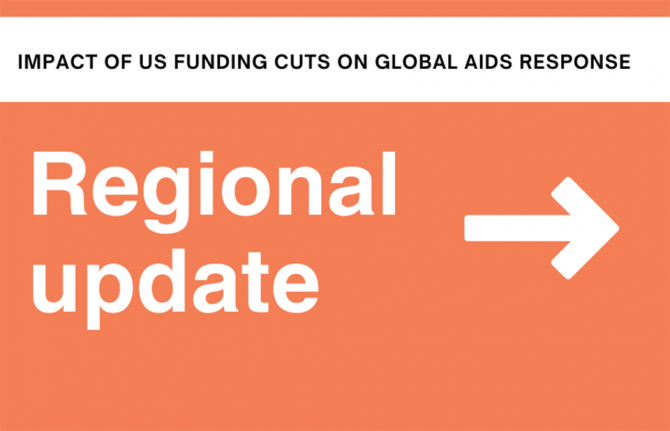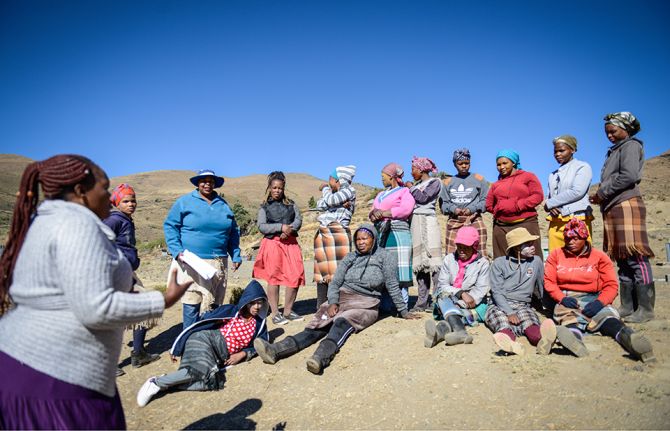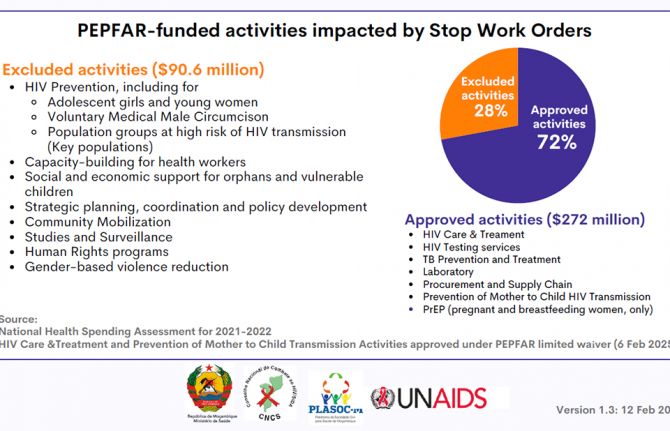
Feature Story
Signs of progress in global response to Children and AIDS
16 January 2007
16 January 2007 16 January 2007
Photo credits : UNICEF
Just over a year ago, UNIC EF, UNAIDS and other partners launched Unite for Children, Unite against AIDS initiative to highlight the missing face of the child in the AIDS response.
On Tuesday, 16 th January 2007 UNICEF released the “Children and AIDS: A Stocktaking” report summarizing progress on children and AIDS since the initiative was launched in October 2005 and highlighting important breakthroughs and progress noted in the global response to Children and AIDS since the campaign launch. Such achievements include real progress noted in some countries in preventing HIV transmission from mothers to children and providing treatment for children living with AIDS.
“There is an urgent need to help children impacted by AIDS,” UNICEF Executive Director Ann M. Veneman said. “Unite for Children, Unite against AIDS is focused on ensuring treatment for HIV-positive children, prevention of mother-to-child transmission and assisting children who have been orphaned by AIDS. We must build momentum to achieve positive results for children.”
Within the UNICEF report, findings are presented on four key areas: preventing mother-to-child transmission, access to AIDS treatment, preventing new HIV infections and support to orphans and vulnerable children.
Preventing mother-to-child transmission
The stocktaking report finds that there are signs of considerable progress in the area of preventing transmission of HIV from mother to child (PMTCT). Some high-prevalence countries in Eastern and Southern Africa have shown particularly encouraging results. In Namibia for example, the percentage of HIV-infected pregnant women who received treatment for preventing HIV transmission to their infants increased from six per cent in 2004 to 29 per cent in 2005. In South Africa the percentage increased from 22 per cent in 2004 to 30 per cent in 2005.
However, despite these gains, the report details how the overall percentage of pregnant women receiving treatment for preventing transmission remains extremely low. In 2005, it was estimated that only nine per cent of pregnant women with HIV in low- and middle-income countries were receiving treatment for preventing HIV transmission to their children.
Access to AIDS treatment
The report also notes particular momentum in the provision of treatment to children living with AIDS, a result of improved testing, better health worker skills, lower drug prices and simpler formulations. Several countries – including Botswana, India, Rwanda, South Africa and Thailand – have been able to scale up HIV treatment for children by integrating it into treatment sites for adults.
Globally, still only one in ten children needing antiretroviral treatment receives it. However, prices of antiretroviral drugs for children have come down dramatically over the past 12-18 months. The report notes that in 2006, the Clinton Foundation HIV/AIDS Initiative negotiated a reduction in the cost of paediatric AIDS treatment to less than $0.16 per day, or $60 per year, helping to spur competition in the development of paediatric formulations.
Preventing new HIV infections
HIV Prevention responses are displaying renewed attention on the need to focus strategies on adolescents and young people most at risk, according to the report. The report notes that young women should be specially targeted since globally, a higher number of young women are being infected than men.
New evidence suggests that declining HIV prevalence in Kenya, urban areas of Cote d’Ivoire, Malawi and Zimbabwe, and in rural areas of Botswana, has resulted from the adoption of safer sexual behaviour by young people. In more than 70 countries surveyed, testing and use of counselling services increased from roughly 4 million people in 2001 to 16.5 million in 2005.
Supporting orphans and vulnerable children
The disparity between orphans and non-orphans in access to education is being significantly reduced in several countries, partly due to the abolition of school fees, according to the report.
The report notes that collecting and disaggregating data by age group and gender is one of the most vital, simple and effective ways of putting children on the AIDS agenda. This report uses for the first time a baseline against which new and existing data can be measured in order to identify discernible trends regarding children and AIDS.
Links:
Read Stocktaking report (2 MB, pdf)
Read 'Preventing mother to child transmission (PMTCT)' Fact Sheet (37 kb, pdf)
Read 'Providing pediatric treatment' Fact Sheet (37 kb, pdf)
Read 'Prevent infection among adolescents and young people' Fact Sheet (37 kb, pdf)
Read 'Protecting and supporting children affected by AIDS' Fact Sheet (39 kb, pdf)
Know more about "Unite for Children, Unite against AIDS" campaign (1,4 MB, pdf)
Visit "Unite for Children, Unite against AIDS" Web Site
Related

Feature Story
ASEAN Summit Special Session on AIDS
13 January 2007
13 January 2007 13 January 2007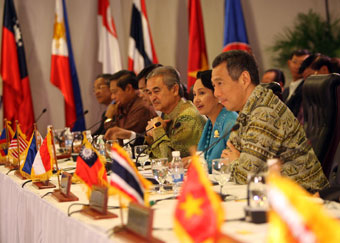
Photo credit: J.Carual-PCPO
“AIDS is not a passing storm but a long-run threat to development and national security in Asia,” UNAIDS reported at the ‘Special Session on HIV/AIDS’, held as part of the 12 th Association of South East Asian Nations (ASEAN) Summit on Saturday 13 January.
The special report from UNAIDS Executive Director Dr Peter Piot on the state of AIDS epidemics globally, in the ASEAN region, and the challenges faced by countries was considered by the Heads of State from 10 ASEAN countries at their extraordinary session on AIDS. This is the first time an external body has been invited to brief the Heads of State Summit on AIDS.
Asia has the second largest number of people living with HIV in the world and its share of the global epidemic is increasing. According to latest estimates, the ASEAN region – which includes Brunei Darussalam, Cambodia, Indonesia, Lao PDR, Malaysia, Myanmar, Philippines, Singapore, Thailand, Viet Nam -shows the most severe epidemics within Asia. In 2006, there were an estimated 1.6 million people living with HIV in the ASEAN region and in some countries up to 1.5% of all adults are living with HIV.
“We are still in the early phases of the epidemic in Asia and must redouble and sustain efforts, not let our guard down,” the UNAIDS report said. “The most worrying fact for the ASEAN countries is that AIDS affects the most productive sections of ASEAN populations, i.e. the workforce which is the powerhouse of economic development of the region,” the report noted.
Underlining AIDS as ‘one of the make-or-break challenges of our time’, the UNAIDS report outlined the threat AIDS poses in the region to the achievement nearly all the Millennium Development Goals. However UNAIDS stressed there are opportunities to put in place a long term response to the epidemic.
The meaningful involvement of community based and civil society organizations – especially people living with HIV – into national AIDS responses must also be a priority. The importance of personal leadership from the Heads of State on AIDS was underlined. “The threat of AIDS will not pass in a year or five years. [UNAIDS] and the world look to you for your continued leadership on AIDS,” the report stated.
The report outlined how a number of countries in the region have made significant progress in ensuring that the most vulnerable communities, including young people, sex workers and their clients, men who have sex with men and injecting drug users, are getting priority in national AIDS responses. In the short-term, increase in scale and size of such programmes focused to reach people most at risk in the region is urgently needed. At the same time programmes need to take into consideration the drivers of epidemics within countries such as gender inequality, homophobia and HIV-related stigma.
The 2007 ASEAN Special Session on AIDS was held in response to the resolution passed at the 7th ASEAN Summit held in Brunei Darussalam in November 2001 where the ASEAN Heads of State and Government agreed to convene the “Special Session on HIV and AIDS” in conjunction with the 12th ASEAN Summit in 2007, to signal ASEAN’s commitment in combating AIDS and to give impetus to regional responses in taking urgent action.
Representing UNAIDS Executive Director Dr Peter Piot, UNAIDS Deputy Executive Director Deborah Landey attended the ASEAN Summit and observed the Special Session.
Following the Special Session, the ASEAN Heads of State are due to adopt a Declaration on AIDS, affirming their commitment to prioritize, lead and strengthen national AIDS programmes ensuring policies and programmes respond to the people most at risk and most in need within the region. “[This Declaration] will form part of the permanent history and lexicon of ASEAN,” said ASEAN Spokesperson, Philippine Ambassador to Malaysia Victoriano Lecaros.
As part of the Special Session, the Secretary-General of ASEAN, Mr Ong Keng Yong delivered his own report to the Heads of State in Cebu. In his report, the ASEAN Secretary-General observed that “commitment of the leadership and political will are key in addressing challenges posed by the spread of HIV and AIDS”. Secretary-General Ong reported to the ASEAN Leaders on progress made since 2001. Mr Ong also outlined key points of action over 2006-10 through an operational work plan for ASEAN’s third regional programme on HIV and AIDS.
“Future ASEAN responses would involve multi-sector initiatives, and closer partnerships with the private sector, civil society, and people living with HIV,” he said. He highlighted the main elements in the Declaration on AIDS, drawing attention to the “commitment on integration of HIV with development priorities to reduce both the impact of development on HIV transmission, and the impact of the HIV epidemic on development, consistent with ASEAN’s commitments to the Millennium Development Goals and the 2006 UN General Assembly decision”.
Links:
Read ASEAN Commitments on AIDS
Read UNAIDS press release ‘Decisive leadership urged for long-term response to AIDS in Southeast Asia’ ( en | fr | es | ru )
Read UNAIDS Executive Director’s report to the ASEAN Heads of State
Visit the web site of the 12th ASEAN Summit
Visit the ASEAN Secretariat web site
Facts and figures on AIDS in the ASEAN region
Related

Feature Story
Words are not neutral against HIV
03 January 2007
03 January 2007 03 January 2007
Words such as ‘HIV positive’ and ‘People living with HIV’ are gradually replacing other terms, such as ‘AIDS sufferers’ and ‘victims of the disease’, which used to flourish in the literature about HIV. Why are we witnessing such a transformation? How does it come about? And most important, what does it mean?
HIV is no longer a purely medical issue: the risk of HIV infection and the impact of HIV feed on social issues, including discrimination against women and groups of people who are marginalized such as sex workers, people who inject drugs and men who have sex with men. It is a regrettable fact that people living with HIV are also often subjected to stigma and violence related to their HIV status. Over the past decade the critical need to strengthen human rights as part of an effective response to AIDS and its effects has become evermore clear.
It is well established that language, in the context of HIV, is not neutral. The words we choose and the way we put sentences together to share ideas and information have a profound effect on the way messages are understood and acted upon, or not. Careful choice of language therefore plays an important part in sustaining and strengthening the response to HIV.
At the UNAIDS Secretariat in Geneva, a small team reflects upon and puts into perspective the issues and dynamics that continually emerge in the field of HIV. Their objective is to make recommendations about language usages that are scientifically accurate, that promote universal human rights and the dignity of the individual, that are easily understood and respect how individuals and groups of people choose to refer to themselves.
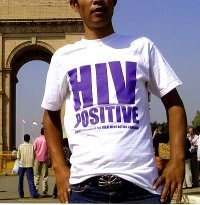
UNAIDS Terminology guidelines focus on
promoting language usages that respect
and empower individuals.
Credits: UNAIDS
For example, choosing terms that focus on specific behaviours rather than on people’s membership of groups is a sound approach to avoid increasing stigma and discrimination. It is preferable to refer to ‘higher risk of HIV exposure’, ‘sex without condoms’, ‘using non-sterile injection equipment’ rather than to generalize by saying ‘high risk groups’. Being a member of a group does not in itself place an individual at risk, but his or her behaviour may.
Respecting and empowering the individual is another principle which is the basis of UNAIDS recommendation to avoid terms such as ‘AIDS victim’ or ‘AIDS sufferer’. “These terms imply that the individual is powerless, with no control over his or her life,” said Alistair Craik, who coordinates the UNAIDS Terminology guidelines. “It is preferable to use ‘people living with HIV’,” he added.
Referring to people living with HIV as innocent victims (which has often been used to describe HIV-positive children or people who have acquired HIV medically) wrongly implies that people infected in other ways are somehow deserving a punishment. It is preferable to consistently use ‘people living with HIV’, or ‘children living with HIV’.
UNAIDS Terminology guidelines also provides advice to writers to avoid making some common errors. For example ‘AIDS virus’ should not be written because it is scientifically wrong. “There is no ‘AIDS virus’,” said Craik, “AIDS, the Acquired Immunodeficiency Syndrome, is a syndrome of opportunistic infections and diseases which is ultimately caused by HIV. This is also why, he adds, people are not infected with AIDS but with the virus called HIV.” Because the letters ‘HIV’ stand for Human Immunodeficiency Virus, “it is incorrect to write the ‘HIV virus’,” notes Craik. Similarly it is tautological to write about ‘commercial sex work’ – ‘commercial sex’ and the ‘sale of sex service’ are more concise and precise expressions.
The examples above are illustrations of what writers can find in UNAIDS’ Terminology guidelines. This brief set of recommendations aims to promote language that is gender-sensitive, non-discriminatory, culturally appropriate and which promotes universal human rights. “We ask readers to understand that UNAIDS’ Terminology guidelines are recommendations: different writers have different ‘voices’; different organizations have different areas of expertise and they may choose to define their own preferences and styles; this is both good and appropriate,” said Craik.
UNAIDS emphasises that its terminology recommendations must be considered a work in progress as new issues and dynamics emerge continually.
Links:
Download UNAIDS Terminology guidelines (March 2007) - En | Fr | Sp | Ru
Guidelines summary (March 2007) - En

Feature Story
UNAIDS in action 2006
22 December 2006
22 December 2006 22 December 20062006 has been an important year in the AIDS response. The number of people living with HIV rose to almost 40 million, the highest number ever, however declines in infection rates were observed in some countries, as well as positive trends in young people's sexual behaviours. HIV Prevention efforts were shown to be working in a number of countries, highlighting the need to urgently scale up, expand and adapt prevention programmes to address the different drivers of the epidemics.
Political commitment to the AIDS response was at its highest level to date which was reflected at the 2006 High Level Meeting on AIDS at the UN in New York. Heads of State and Government and representatives of States and Governments came together to debate key AIDS issues and unanimously adopted a political declaration on AIDS. During the meeting countries also pledged to set ambitious national targets for universal access to HIV prevention, treatment care and support. By the end of 2006 many countries had already set their targets.
In 2006, key developments were brought to light in the field of scientific research—including increased emphasis on microbicide development and findings relating to male circumcision. More people than ever before were receiving antiretroviral treatment and funds pledged for the AIDS response reached their highest levels to date.
2006 also marked 25 years since the virus was first discovered over which time some 25 million people have died of AIDS.
2006 was also the 10 th anniversary of the Joint United Nations Programme on HIV/AIDS (UNAIDS) during which time UNAIDS has spearheaded many innovative initiatives that have accelerated the AIDS response worldwide.
In 2006 , UNAIDS enlisted the help of a number of new special representatives to strengthen communication of key messages and reach out a broader audience than ever before.
Below are some of the highlights and key events which took place during 2006.
| JANUARY | |
| AIDS: everybody’s business | |
 |
Business leaders met in Davos in January for the 2006 World Economic Forum, many turned their attention to the issue of the increasing impact of AIDS in the workplace. |
| The road towards universal access | |
|
As requested by the General Assembly in resolution 60/224 adopted in December 2005, UNAIDS secretariat and co-sponsors started facilitating inclusive, country-driven processes to identify practical actions for scaling up AIDS services towards universal access. Thousands of people from all walks of life were mobilized to seize this extraordinary opportunity. Between January and March, more than 100 low- and middle-income countries held broad public debates about what needs to be done to turn back the epidemic. Seven regional consultations were held. The UNAIDS secretariat also convened a multipartner Global Steering Committee. |
|
| FEBRUARY | |
| The need to invest in HIV prevention | |
|
A study, published in Sciencexpress in February, indicated that increased spending on HIV prevention would not only prevent more than half the new infections that would occur from 2005 to 2015, but would actually produce a net financial saving as future costs for treatment and care are averted. |
|
| World not doing nearly enough to protect children affected by AIDS | |
|
In February, the Global Partners Forum, hosted by UNICEF and the UK Department for International Development, brought together 90 international organizations, NGOs and governments in a special effort to ramp up practical responses for children affected by the AIDS epidemic. |
|
| Innovative AIDS funding takes off | |
|
An international conference on “Solidarity and Globalization: innovative financing for development and against pandemics”, held in Paris in February, brought together representatives from more than one hundred countries, 18 international organizations and 60 NGOs to discuss the implementation of innovative financing for development. |
|
| AIDS mission to Rwanda to discuss next steps in AIDS response | |
|
In February, leading representatives from Luxemburg, the United Kingdom’s Department for International Development, UNICEF and the Joint United Nations Programme on HIV/AIDS visited Rwanda for a two-day, high-level mission to gain a joint perspective on the progress of the national AIDS response and the ongoing challenges it faces. |
|
| MARCH | |
| Economic security for women key to HIV prevention | |
| |
A new paper published in March by the UNAIDS-led Global Coalition on Women and AIDS showed that when women have an income and a safe place to live, they are much better able to negotiate abstinence, fidelity, and safer sex. Economic security, the paper stressed, is a major factor in enabling women to protect themselves from HIV. |
| Positive partnerships break down AIDS-discrimination in Thailand | |
| |
Heralded by UNAIDS as an example of ‘best practice’, a project that offers small loans to enable people living with HIV set up businesses is helping break down stigma and discrimination in Thailand. |
| Global access to HIV therapy tripled in past two years, but significant challenges remain | |
|
A new report by the World Health Organization (WHO) and the Joint United Nations Programme on HIV/AIDS (UNAIDS) shows that the number of people on HIV antiretroviral treatment (ART) in low- and middle-income countries more than tripled to 1.3 million in December 2005 from 400 000 in December 2003. Charting the final progress of the "3 by 5" strategy to expand access to HIV therapy in the developing world, the report also says that the lessons learned in the last two years provide a foundation for global efforts now underway to provide universal access to HIV treatment by 2010. |
|
| APRIL | |
| Declaration of Commitment on HIV/AIDS: five years later – Report of the Secretary General | |
|
The report of the Secretary-General provided an update on progress in the global AIDS response since the 2001 special session, identified critical challenges and made urgent recommendations to strengthen efforts at the global, regional and country levels. |
|
| UNAIDS assessment report on the road towards universal access released | |
|
Reaching the Millennium Development Goal on HIV and AIDS – to halt and reverse the spread of the epidemic by 2015 – requires far greater access to HIV prevention services and AIDS treatment, care and support than is currently available. The assessment report includes an analysis of common obstacles and recommendations for overcoming them by integrating HIV prevention, treatment, care and support with broader health and social services. |
|
| President Putin calls for urgent measures to stem the HIV epidemic in Russia | |
| |
President Vladimir Putin gathered the Presidium of the State Council to discuss the HIV epidemic in Russia. In a groundbreaking move, the State Council examined all aspects of the growing epidemic in the country and agreed on a set of measures that will strengthen Russia’s response to the epidemic in an unprecedented manner. |
| MAY | |
| Launch of the 2006 Report on the global AIDS epidemic | |
| |
On the eve of the 2006 High Level Meeting on AIDS in New York UNAIDS launched the 2006 Report on the global AIDS epidemic, featuring the latest AIDS estimates and new trends. The report, a special edition marking UNAIDS' 10th anniversary, contained the most in-depth data from countries to date, based on progress reports from 126 countries. |
| Eastern Europe and Central Asia are facing the challenge | |
| |
Under the theme “facing the challenge” the first Eastern European and Central Asian AIDS conference welcomed around 1500 participants in Moscow from 15 to 17 May. The conference provided an important forum for political leaders, scientists and researchers, people living with HIV and representatives from civil society to take stock of the AIDS response in the region. |
| JUNE | |
| Agenda for action on women and AIDS | |
|
On 1 June, the UNAIDS-led Global Coalition on Women and AIDS launched a new Agenda for Action - calling for massively scaled-up funding for AIDS programmes for women and girls; the effective enforcement of laws that affirm and protect women's rights, and greater involvement in women (particularly positive women) in forums where AIDS policies and programmes are decided. |
|
| 2006 High Level Meeting on AIDS | |
| |
High-level representatives of over 140 UN Member States, including nearly a dozen Heads of State and Government, met in June to review progress towards achieving the agreed goals of the Declaration of Commitment on HIV/AIDS adopted at the UN General Assembly Special Session on AIDS in 2001. The 2006 High Level Meeting on AIDS concluded with a renewed political commitment and agreement on future action to reverse the global AIDS epidemic and reduce its impact. |
| Gauging progress in Malawi | |
| |
Dr. Peter Piot, Executive Director of UNAIDS and Sir Suma Chakrabarti, Permanent Secretary, United Kingdom Department for International Development visited Malawi to review progress made in the country’s AIDS response. Malawi’s political leadership and commitment in accelerating universal access to HIV prevention, treatment care and support was one of the focal points of the visit. |
| JULY | |
| Investigating the impact of AIDS in Asia and the Pacific | |
|
A new body to study the spread and impact of HIV and AIDS in the Asia Pacific region was launched in July in New Delhi. The Independent Commission on AIDS in Asia and the Pacific consists of 10 leading economists, scientists, civil society representatives and policy-makers from across the region. |
|
| UN Secretary-General meets pharmaceutical companies to discuss access to treatment | |
| |
The UN Secretary-General met with CEOs from the world’s leading pharmaceutical companies and UN officials in New York to explore ways to expand access to HIV treatment and care in low-and-middle income countries. The meeting was the first of its kind to include both research and development - or ‘brand name’ – pharmaceutical companies, generic development companies and UN bodies. |
| Health leaders welcome infectious disease focus at G8 | |
| |
In advance of the G8 summit, the leaders of the four key health policy and financing organizations - the World Health Organization (WHO),UNAIDS, the Global Fund to Fight AIDS, Tuberculosis and Malaria, and the GAVI Alliance - jointly welcomed the focus on infectious diseases and urged the G8 leaders to continue their commitments to improving the health and lives of people in the world's poorest countries. |
| AUGUST | |
| UNAIDS Executive Director meets with Indian Prime Minister | |
|
Dr Peter Piot met with Indian Prime Minister Dr Manmohan Singh in August. The Prime Minister's leadership has put the AIDS response on the national political agenda. As the Chairperson of the National Council on AIDS, Dr. Singh has developed a multi-ministerial task force comprising of 31 ministries and seven state governments for a coordinated multi-sectoral response to the HIV epidemic in India. |
|
| XVI International AIDS Conference, Toronto, Canada | |
| |
Over the week 13-18 August, 24,000 people participated in the XVI International AIDS Conference, including high-profile guests such as former US President Bill Clinton, Bill and Melinda Gates, leaders from governments, the science sector, civil society, people living with HIV, youth and women’s groups, United Nations officials, business, the private sector and the entertainment sector. UNAIDS took part in a wide variety of satellites, sessions and events over the week. |
| Uniting for HIV Prevention | |
| |
UNAIDS, civil society, treatment activists, private sector and governments call for ‘out of the ordinary partnerships’ to intensify HIV prevention efforts. |
| SEPTEMBER | |
| Responding to AIDS in China | |
| |
UNAIDS Executive Director Peter Piot visited China in September to encourage continued leadership and commitment and to mobilize a multi-sectoral response to AIDS. |
| Emerging epidemics in Eastern Europe on the agenda | |
|
In September, UNAIDS Executive Director Dr Peter Piot visited Berlin to discuss ways of strengthening collaboration between UNAIDS and Germany and to promote continued commitment to the AIDS response. Dr Piot met with Government Ministers, parliamentary representatives, the National AIDS Council and NGO representatives. |
|
| OCTOBER | |
| Setting ambitious national targets: The next step on the road towards universal access | |
| |
In October, UNAIDS published new, operational guidelines to support countries’ efforts to set ambitious national targets that reflect international commitment to scale up significantly towards the goal of universal access to comprehensive prevention programmes, treatment, care and support by 2010. |
| NOVEMBER | |
| Asia Pacific: Call for action on AIDS | |
| |
Asia and Pacific countries with low HIV prevalence rates called for action to increase targeted HIV prevention efforts and funding for AIDS, at the ‘Low to Zero’ Asia Pacific regional conference on universal access to HIV prevention, treatment, care and support in low prevalence countries, that took place in Mongolia in October. |
| UN Secretary General visits UNAIDS, Geneva | |
| |
In one of his final public appearances as UN Secretary General, Kofi Annan visited UNAIDS in Geneva on Monday 20 November. The Secretary General urged the international community to continue to “fight to bring the global AIDS epidemic under control.” |
| UNAIDS/WHO launch 2006 AIDS epidemic update | |
| |
UNAIDS launched the new joint UNAIDS/WHO report, AIDS Epidemic Update 2006, featuring updated global and regional AIDS estimates and new trends in the epidemic’s evolution on 21 November 2006. |
| DECEMBER | |
| World AIDS Day 2006 | |
| |
With nearly 40 million people living with HIV in 2006, this year's World AIDS Day theme of 'accountability' was a poignant reminder that we all have a role to play in the AIDS response and we are all accountable for the promises we have made. On 1 December events took place around the globe to commemorate this special day of remembrance and hope. |
| Setting targets for universal access to HIV prevention, treatment, care and support | |
| |
Throughout 2006, countries across the world have been taking positive steps to accelerate their national response in order to halt and reverse the AIDS epidemic by 2015. By the end of 2006, a number of countries had already set ambitious national targets, while others, building the process into their existing national strategic planning cycle, are due to continue this process throughout the coming months. |
| Statement on trial findings regarding male circumcision and HIV | |
|
UNAIDS and its Cosponsors, WHO, UNFPA, UNICEF and the World Bank, release a joint statement regarding the announcement by the US National Institutes of Health that two trials assessing the impact of male circumcision on HIV risk are being stopped on the recommendation of the NIH Data Safety and Monitoring Board (DSMB). |
|
Related

Feature Story
2006 World AIDS Day events
21 December 2006
21 December 2006 21 December 2006To view the pictures from World Aids Day events you require the Flash Plugin Download it here.

World AIDS Day 2006 commemoration at UNAIDS/WHO
The World AIDS Day celebration at UNAIDS/WHO Headquarters in Geneva, was organized by the UN family, missions, NGO's, humanitarian organizations, people living with HIV and faith communities. The lighting and placing of red candles forming a ribbon and the signing of promises onto a commemorative ribbon were two of the activities that took place after the opening remarks by Dr. Peter Piot, Executive Director, UNAIDS and other special guests.

World AIDS Day 2006 commemoration in Nigeria
UNAIDS coordinated the UN support to the WAD ceremony, including exhibition stands with condom promotion and demonstration and drama performances. UNAIDS and UN staff also participated in the rally of PLHIV to the National Assembly and to the office of the Minister of the Federal Capital Territory.

World AIDS Day 2006 commemoration in South Africa
The UNAIDS Country Office in South Africa in partnership with Cricket South Africa uses sport as a platform for promotion of HIV Prevention. The pictures were taken during . UNAIDS and Cricket South Africa decided to use the Standard Bank International Pro20 Cricket Match between South Africa and India played in Johannesburg, South Africa on the 1st of December 2006 to commemorate World AIDS Day.
The Captain of the South Africa Cricket Team – Graeme Smith gave a speech on the impact of HIV in South Africa, the need to support people living with HIV, and the importance of knowing your HIV status.
Public Service Announcements (PSAs) from the World AIDS Campaign were also broadcasted during the match (as shown in pictures)

World AIDS Day 2006 commemoration in Panama
UNAIDS RST Office for Latin America in coordination with UNAIDS Panama carried out two visibility events for the commemoration of the WAD. One was carried out in the Miraflores Locks of the Panama Canal and the other at the Tocumen International Airport.

World AIDS Day 2006 commemoration in Papua New Guinea
The World AIDS Day was a symbolic event in Port Moresby used as a platform to promote HIV testing and counseling under the national theme “Stop AIDS: You have the right to know’. The national preparations for the 2006 World AIDS Day were facilitated by the civil society umbrella body PACSO (PNG Alliance of Civil Society Organization) which is supported by UNAIDS-PNG.
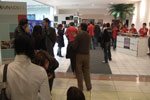
World AIDS Day 2006 commemoration in Macedonia
The World AIDS Day in Macedonia was organised jointly by UNAIDS, the Ministry of Health and local NGOs, and took place in a shopping Mall in its capital, Skopje. There were two info-educational stands where young people from local NGOs offered information on AIDS prevention and distributed booklets, condoms and red ribbons to all visitors, while mobile NGO teams circulated throughout the mall attracting people to write massages that were used to create a “Red message Ribbon”. During the WAD, a photographic exhibition on AIDS, consisting of 40 photographs made by young people, was also inaugurated.
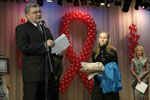
World AIDS Day 2006 commemoration in Belarus
UNAIDS supported the Belarusian Youth Festival of Universities “Stop AIDS. Keep the Promise” held in Minsk 1 December 2006. The Youth Festival was organized by all Universities within the National Plan of Actions on the World AIDS Day 2006. Every University contributed to the Festival with their projects on anti-stigma, health behavior and life skills. The Festival was opened by the Vice-Minister of the Ministry of Health.
Another WAD activity sponsored by UNAIDS was the “Leave Positively!” event organized by the NGO of PLHIV “Positive Movement”. The event scenario was centered around a concert where participants wrote messages to PLHIV. The exhibition of the Red Bells messages will start a tour among self-support groups of PLHIV all over Belarus.

World AIDS Day 2006 commemoration in Burundi
The commemoration of the World AIDS Day 2006 in Burundi extended to all 17 provinces of the country. The Burundi Alliance against AIDS (ABS), a network of 140 national associations, mobilized its members across the country to work closely with the provincial governments to organize World AIDS Day events and present their achievements from the past year. Delegations of high government representatives visited all provinces of the country, where communal ceremonies included parades, film screenings, photo exhibits, sports competitions and cultural performances. Delegates from networks of people living with HIV, the National Alliance against AIDS, and Women and Youth groups addressed local audiences. The President of the Republic launched the National Strategic Plan for 2007-2011.

World AIDS Day 2006 commemoration in Lesotho
The World AIDS Day commemoration in Lesotho was marked by the support of King Letsie III to the national plans to address AIDS in the country. The King also launched the first ever "Know Your Status" campaign during the World AIDS Day commemorations .
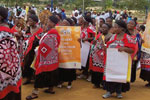
World AIDS Day 2006 commemoration in Swaziland
The UNAIDS Country Office in Swaziland in partnership with the Swaziland Government, the national AIDS coordinating body, as well as several national and international NGOs working in Swaziland commemorated World AIDS Day with a Ten Day Campaign leading up to the climax day on December 1st. During the campaign offices across the country displayed candles with the red ribbon and promises boxes where people were encouraged to make a pledge and keep the promise. On December 1st a march and run were held to commemorate World AIDS Day 2006. The event also featured songs by the traditional women’s regiment (Lutsango), dramas and songs by school children, music, and dance all focused on HIV. There were also information booths by NGOs working on HIV in the country, and mobile testing units in line with the focus on HIV Prevention.

World AIDS Day 2006 commemoration in Thailand
UN agencies and civil society organisations teamed up to organise a World AIDS Day event led by UNESCO and Thai Red Cross. The event, which took place at Lumpini Park and Thai Red Cross Compound in Bangkok on the 1st of December 2006 was billed as the “Condom Chain of Life Festival” and included setting a new Guinness Book of Records mark for the world’s longest chain of condoms intended to raise awareness around HIV prevention. The World AIDS Day commemoration included a parade organized by the Thai Red Cross involving HRH Princess Somsawalee, games, activities and performances around AIDS issues. Tents and pavilions were organized by UN agencies and NGOs working on HIV related issues to disseminate information.
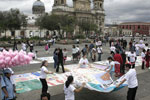
World AIDS Day 2006 commemoration in Guatemala
To commmemorate The International World AIDS Day 2006, El Día Mundial en la lucha contra el SIDA, the activity of Quilts in the Central Park, in front of Palacio Nacional de la Cultura, Guatemala City, Guatemala, C.A.
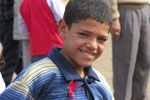
World AIDS Day 2006 commemoration in Egypt
As part of the Sailing the Nile for the Millenium Development Goals (MDGs) project, initiated by the UN and its partners, eight felucca boats, each representing a Goal, sail the Nile to promote action to fulfill the MDGs in Egypt. On December 1st, the boats stopped in Beni-Suef to promote the 6th MDG, that aims to combat HIV, malaria and other diseases, and to commemorate World AIDS Day. The organised events included HIV education training-of-trainers sessions with youth and the promotion of volunteerism; workshops with religious leaders to spread AIDS awareness messages; and welcome the feluccas with a parade, display of banners, song and dance performances. In addition to the activities planned in Beni-Suef, AIDS awareness campaigns were orchestrated by local organizations in Cairo, Sohag, Qena, Luxor, Aswan, and Assiut, with events ranging from awareness-raising and training-of-trainers to competitive sports and dramatic performances.

Feature Story
A faith-based response to HIV in southern Africa
20 December 2006
20 December 2006 20 December 2006Nazareth House, a faith-based organization located in Cape Town, was the first Catholic orphan care institution in South Africa to provide paediatric antiretroviral therapy for the HIV-positive orphans it cares for.
The Sisters of Nazareth House are currently caring for 35 children made orphans by AIDS and 20 adults living with HIV, most of whom, due to the complexity or severity of their symptoms can no longer care for themselves or be cared for by their family or community.

Photo credits : UNAIDS/L. Alyanak
Like Nazareth House, many faith-based initiatives have been on the front-line of the epidemic since its devastating effects on the population became apparent in Africa. Nowadays, faith-based organizations, which often reach the most remote communities, as well as being prominent in large urban centres, are uniquely placed to provide a range of quality HIV-related services (from training of home-based caregivers to provision of antiretroviral therapy) to those in need.
However, the valuable work of organizations within the Catholic Church based upon their religious principles sometimes lacked the coordination and level of support needed to improve the effectiveness of their responses to the AIDS epidemic.
It was under these circumstances that the Southern African Catholic Bishops’ Conference (SACBC), in partnership with the Catholic Medical Mission Board, launched the Choose to Care initiative. The initiative, supported by funding from the Bristol-Meyers Squibb Foundation and other sources, started in 2000 as a coordinated response to the overwhelming need to provide HIV-prevention education, care and support to communities in the southern African region.
“Since 2000 the SACBC AIDS Office has coordinated the response of the Catholic Church to AIDS in South Africa, Swaziland and Botswana, strengthening and building on existing programmes, as well as helping to initiate new ones. The continuum of Choose to Care in most of the programmes and projects linked to the SACBC has seen commitment to prevention, care and support to people infected and affected by AIDS,” stated Mr. Johan Viljoen, Programme Manger of Choose to Care Project.
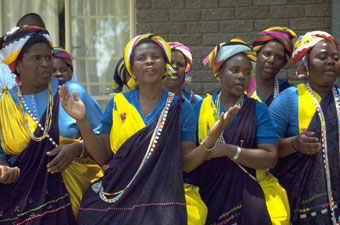
Photo credits : UNAIDS/L. Gubb
At first the Choose to Care projects were engaged in providing prevention and care services. However, the provision of treatment to those living with HIV, particularly orphans and vulnerable children, has become one of their main activities. The sites supported by the SACBC providing antiretroviral therapy aim at complementing government programmes in areas where government-funded antiretroviral therapy is not available, notably in resource-poor communities.
Nazareth House was one of the first sites where antiretroviral therapy was provided as part of the Choose to Care initiative. By replicating similar small-scale programmes implemented through the diocesan and parish system, the Catholic Church has been able to scale-up HIV programmes that remain rooted in and responsive to the needs of local communities.
This approach has been proven to be effective as is shown in a study recently researched and written by Rev. Robert J. Vitillo, Special Adviser on HIV for Caritas Internationalis. The study has now been published as part of the UNAIDS Best Practice Collection as an example of how a coordinated response to the epidemic made by a faith-based organization has increased HIV prevention education, care and support to communities affected by AIDS as well as complementing governments’ efforts to achieve universal access to prevention, treatment, care and support.
“The highly variable nature of the epidemic has been met with a wide variety of Best Practice responses. The Choose to Care initiative is especially interesting as it provides evidence that a large scale response to HIV may be achieved through support, coordination and guidance given to a large number of locally-rooted small-scale programmes,” noted Alistair Craik, Best Practice Manager, UNAIDS.
Drawing upon independent research the study shows that the Choose to Care projects are valued both for their compassion and practical effectiveness. Further proof of the strength and effectiveness of the Choose to Care model is provided by the fact that since 2005 when, as planned, funding support ceased, the great majority of projects have continued, sustained by new sources of support.
Related

Feature Story
Joint UNAIDS / DFID delegation visit to India
19 December 2006
19 December 2006 19 December 2006AIDS leaders from the United Kingdom and the Joint United Nations Programme on HIV/AIDS (UNAIDS) came together in India for a joint mission to gain greater insight into the country’s AIDS response. During the four-day visit, Sir Suma Chakrabarti, Permanent Secretary at the Department for International Development (DFID) and Dr Peter Piot, Xecutive Director of UNAIDS met with political leaders, senior government officials and parliamentarians, students, representatives from non governmental organizations and from the donor community.
As part of the mission, the delegation visited Patna in the North Indian state of Bihar on Saturday 16 December where Dr Piot and Sir Chakrabarti noted the significant progress made in this province since their last visit, including the establishment of India’s first ‘Legislative Forum on HIV and AIDS’ to raise AIDS awareness among policy makers in the state and to build capacity to address the challenges posed by AIDS.
|
|
Dr. Peter Piot, Executive Director, |
|
Mr. Nitish Kumar, Chief Minister of Bihar |
|
Dr.Peter Piot. Executive Director, UNAIDS addressing the gathering of Elected People’s Representatives in the State Capital of Patna on 16th December 2006 |
|
Sir Suma Chakrabarthi, Parmanent Secretary of the Department for International Development (DFID) addressing the gathering |
|
Heads of the Joint Mission Dr. Peter Piot, Executive Director, UNAIDS and Sir Suma Chakrabarti, Parmanent Secretary of the Department for International Development (DFID) greeting His Excellency R.S.Gavai, the Governor of Bihar State and the Chancellor of Patna University with the Speaker of Bihar Legislative Assembly, Mr. Uday Narain Chowdhury during the interactive session with students at the Wheeler Senate Hall, Patna University, Patna on 16th December 2006. |
|
A cross section of the gathering at |
In New Delhi, the joint delegation met with political leaders and senior officials including the Indian Minister of Health and Family Welfare, Dr. Anbumani Ramadoss, the Indian Minister of Finance, P. Chidambaram and Sitaram Yechury, Polit Bureau Member of the Communist Party of India.
|
Dr. Peter Piot, Executive Director UNAIDS and Sir Suma Chakrabarti, Parmanent Secretary of the Department for International Development (DFID) during their meeting with Dr. Anbumani Ramadoss, Indian Minister of Health & Family Welfare in New Delhi, India on Monday 18 December 2006 |
|
Dr. Anbumani Ramadoss, Indian Minister of Health & Family Welfare with Dr. Peter |
|
Dr. Peter Piot, Executive Director UNAIDS and Sir Suma Chakrabarti Parmanent Secretary of the Department for International Development (DFID) meet with Sitaram Yechury, Polit Bureau Member of the Comunist Party of India |
|
From left to right Indian Minister of |
|
Dr. Peter Piot, Executive Director UNAIDS and Sir Suma Chakrabarti, Parmanent Secretary of the Department for International Development (DFID)exchange notes after meeting with Indian Finance Minister P. Chidambaram outside his office at North Block in New Delhi, India on Monday 18 December 2006. |
Photo credit for New Delhi : S. Sharma
Related

Feature Story
Local initiatives push for change in India
18 December 2006
18 December 2006 18 December 2006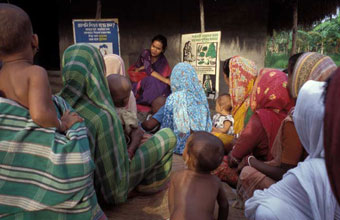
Photo credits : UNAIDS/M. Jensen
Political leaders in the north Indian State of Bihar were urged to rapidly scale up HIV awareness, prevention, care and support by AIDS leaders from the United Kingdom and the Joint United Nations Programme on HIV/AIDS (UNAIDS) during a special joint delegation visit on Saturday 16 December. At the same time, the delegation commended the commitment in the State to achieving these aims.
On a one-day visit to Bihar at the invitation of the State Government of Bihar, Sir Suma Chakrabarti, Permanent Secretary, Department for International Development (DFID) of the United Kingdom and Dr Peter Piot, Executive Director of UNAIDS, met with key political figures and visited the University. The joint delegation commended the political leaders’ resolve to fight AIDS and called for sustained political commitment, greater support from development partners and continued participation of elected representatives in strengthening a decentralized response to the HIV epidemic.
The joint mission was an opportunity to explore how local responses to the AIDS epidemic can be supported and strengthened through initiatives that are locally sensitive and aligned with commitments made at the global level.
In July 2006, Bihar became the first north Indian state to establish a legislative forum with a formal constitution and institutional mechanism for elected representatives to address AIDS issues in the State. The “Bihar Legislative Forum on HIV and AIDS” was launched as a way to raise awareness among political leaders in the State at all levels and to support a stronger capacity of all sectors to address the challenges posed by AIDS.
Since the inception of the forum, Bihar leaders have been advocating this approach with their political peers. Six other states in the northern region of India have now committed themselves to replicate the Bihar model. However, it was emphasized that leaders’ commitment is only one of the steps for a successful AIDS response.
In his speech at the Bihar Legislative Assembly, Dr. Peter Piot indicated that the state had to face “the challenge of strong leadership, management and coordination of all AIDS activities and the challenge of reaching ALL of Bihar’s people to effectively prevent and treat HIV infection.”
Sir Suma Chakrabarti emphasized that “action is needed to spread accurate messages so that people, especially women, can protect themselves. Action is also urgently needed to tackle stigma and discrimination faced by people living with HIV.”
As part of the visit, the joint delegation met representatives of the government, the legislature, civil society, United Nations staff and donor agencies to explore ways to improve the coordination of resources for AIDS control at all levels. The delegation recommended that the technical and financial resources of development partners be pooled to ensure that the Bihar AIDS response keeps pace with the evolving nature of the epidemic, and to ensure that technical and financial support is in line with the needs of the State AIDS Control Society to reach all high risk groups. “The State AIDS Control Society should regularly inform you, the people’s representatives, on the progress of the HIV control programme in Bihar,” argued Dr. Peter Piot, in speaking to the Bihar Legislative Forum.
Although Bihar’s HIV prevalence rate is lower than the national HIV prevalence rate of 0.9%, the social drivers of the epidemic make it particularly vulnerable. One in six people are migrating to urban centres in search of work and a better standard of living. Wide-spread stigma and misconceptions are causing marginalization and exclusion. The state’s vulnerabilities are compounded with a backdrop of increasing levels of sex work and low levels of condom use.
During the visit to Bihar, the joint delegation emphasized the need for a muti-sectoral response, including HIV prevention, treatment, care and support. Nothing less than such a comprehensive response can ensure that all people living with HIV and all those people at high risk of infection have access to vital HIV services. DFID and UNAIDS underlined their support to Bihar in its continuous efforts to control the AIDS epidemic.
The one-day visit to Bihar was part of a wider joint DFID / UNAIDS mission to India in which Dr Piot and Sir Chackrabarti will also meet with political leaders, senior government officials and parliamentarians, students and representatives from non governmental organizations and from the donor community in Delhi.
RHC
Related

Feature Story
Ambitious targets set in Malawi
15 December 2006
15 December 2006 15 December 2006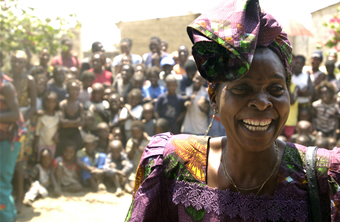
Photo credits : UNAIDS/C. Giray
In Malawi, the involvement of civil society in the process of setting targets for universal access to HIV prevention, treatment, care and support has resulted in ambitious targets addressing the needs and expectations of those living with or affected by HIV.
“Malawi is well on the way to endorsing targets,” said Desmond Johns, UNAIDS country coordinator in Malawi. “We’ve seen a process with limited civil society involvement grow into a process with meaningful dialogue and participation. All of this is producing a much better end result,” he added.
The process of setting targets for universal access in Malawi began early in 2006 when a small group of partners made up of representatives from the national ministries, donor organizations, the United Nations and non-governmental organizations met to identify the objectives and challenges to scaling up the country’s national response. Only two national and two international civil society umbrella organizations took part to this initial consultation.
Noting the limited role attributed to national civil society at this stage, a group of 20 organizations, led by Action Aid and the National Association of People Living with HIV & AIDS in Malawi (NAPHAM), decided in March 2006 to form a coalition in order to articulate a stronger position on the question of universal access. Starting a parallel process, the coalition undertook to review and if necessary challenge the preliminary targets set by the working groups.
The incentive to combine both processes and establish a truly inclusive mechanism to set targets for scaling up the response to AIDS came after the Global Fund review in June and July which revealed that many of the targets established by the working groups had already been exceeded.
“We were in presence of two parallel processes which did not communicate and could not benefit from each other’s strengths,” said Johns. “This situation underlined how important it is to bring all stakeholders around the same table. As of October, this became UNAIDS priority,” he added.
A three-day consultation was held soon after which brought together 350 participants from a wide range of stakeholders. Sixteen representatives from faith and community based organizations and groups of people living with HIV gave presentations on their experiences and the challenges they faced in responding to the epidemic in their communities. The presentations added a new and fresh perspective to the discussions.
In November consultations were extended to the provincial and district levels to ensure the widest possible participation. An international consultant facilitated the discussions to give everyone an opportunity to contribute. He also arranged to seek and incorporate the views of those who could not attend the meetings and gave them time to review the targets and submit comments before they were consolidated.
“We finally felt that our voices were being heard and taken into account,” said Sembereka from Malawi Network of Religious Leaders living with or Personally affected by HIV and AIDS, and member of the secretariat of the Civil Society coalition on Universal Access. “We represent people living with or affected by HIV and this is an unprecedented opportunity to make a difference in the response to HIV. There remains a lot of room for improving civil society participation. Our contribution should be an integral part of planning and monitoring the scale up of the response to AIDS,” he added.
The final national level stakeholder meeting took place on 29 November to communicate the proposed targets and the revised and costed National Action Framework. The targets are due to be endorsed by a Cabinet of Ministers before the end of the year.
“The inclusive process in November was an opportunity to bring a greater level of ambition to the universal access targets, develop consensus and build ownership of the targets and to prioritize and cost the National AIDS Framework, so that it would constitute the implementation plan for Universal Access. This is a great example of the Global Task Team recommendations and Paris Declaration actually taking life,” concluded UNAIDS Country Coordinator Desmond Johns.
RHC
Links
Link to civil society briefing note
Link to civil society page
Link to universal access page
Related
 “Who will protect our young people?”
“Who will protect our young people?”

02 June 2025
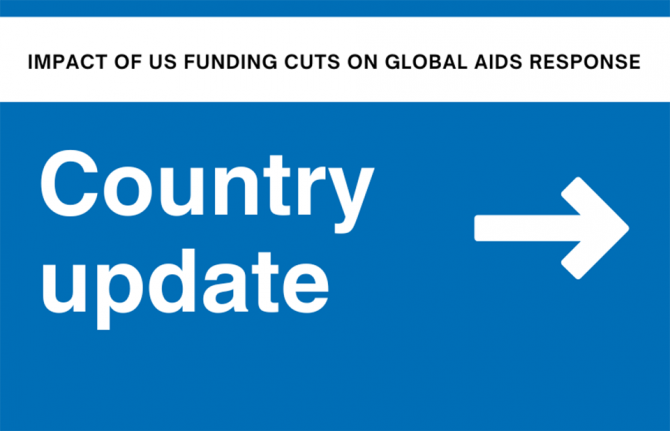 Impact of US funding cuts on HIV programmes in Malawi
Impact of US funding cuts on HIV programmes in Malawi

15 April 2025

Feature Story
UNAIDS helps secure grants in the Middle East and North Africa
13 December 2006
13 December 2006 13 December 2006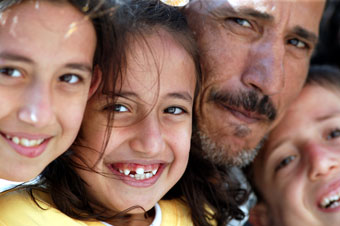
The number of people living with HIV in the Middle East and North Africa has risen to 460,000 and some 68,000 people were newly infected in 2006 alone. In a bid to curb the region’s growing epidemic, countries have been working with UNAIDS to secure additional funding to scale-up the AIDS response in the region.
Securing external funding is particularly challenging in the Middle East and North Africa due to limited support from external donors. One of the donors operating in the region is the Global Fund to fight AIDS, Tuberculosis and Malaria which has now become one of the main sources of AIDS funding for the region. The fund was created in January 2002 to attract, manage and disburse additional financing to support locally-driven strategies in response to AIDS, TB and malaria.
To date, the Global Fund has approved a total of US$ 6.6 billion to over 450 grants in 136 countries. Of the US$ 6.6 billion approved, US$ 2.9 billion has been disbursed to public and private recipients in 129 countries.
The grant application process can be complex and many countries in the region have solicited UNAIDS to assist in processing their applications. UNAIDS has played a role in raising awareness and creating a climate which has enabled countries to establish a country coordination mechanism thus making it possible to develop their grant proposals. UNAIDS facilitates provision of technical expertise to these areas and helps countries not only to develop their grant applications but also to implement the grants once approved.
In the most recent round of grants (Round Six) UNAIDS Regional Support Team and Country Offices in the Middle East and North Africa worked with five countries in the region to help formulate their proposals. Grants were approved for four out of the five countries with funding amounting to some US$ 26 million.
“UNAIDS works with countries at every opportunity to help ‘make the money work’ so that funds reach the people that need them most,” said Michel Sidibe, Director of UNAIDS Country and Regional Support Department. “As countries move towards the goal of universal access to HIV prevention, treatment, care and support, adequate funding from both external and domestic sources is absolutely vital.”

Currently, 13 out of the 22 countries in the Middle East and North Africa meet the eligibility criteria for Global Fund support and 10 out of 11 countries who have applied for Global Fund funding for AIDS to date have succeeded in obtaining funds, amounting to a total of US$ 127 million.
The UNAIDS Secretariat has provided assistance in developing 73% of all the proposals on AIDS in the region that have been approved between Rounds One and Six, including support to proposals from Algeria, Djibouti, Jordan, Morocco, Somalia, Sudan, and Tunisia.
As well as working with countries on grant proposals, UNAIDS also continues to support the implementation of grants and resolve major coordination and implementation difficulties or capacity-building challenges in all countries where grants were already in place from earlier rounds. Through the Global Implementation Support Team – GIST - UNAIDS, together with Cosponsors and the Global Fund headquarters, are providing a common action plan to support counties in solving bottlenecks, at the request of countries.
Typically the activities funded by the grants are wide-ranging and include development of second-generation surveillance and monitoring and evaluation; working with people most at risk of HIV infection such as young people, people who inject drugs and sex workers; reinforcing civil society––including non-governmental organisations, community-leaders and people living with HIV; increasing access to care, treatment, and psycho-social support of people living with HIV; and other specific interventions, such as coordination, blood safety, voluntary counselling and testing, and sexually transmitted infections.
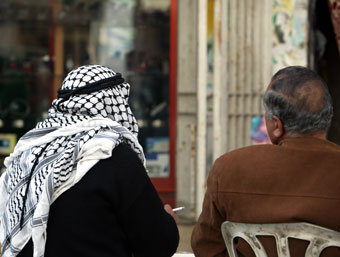
“The availability of Global Fund resources in the region have created a new reality and represents a critical turning point in the national responses in the Middle East and North Africa,” said Oussama Tawil, Director of UNAIDS Regional Support Team for the Middle East and North Africa. “This is essential in particular in a context where the allocation of public resources remains relatively limited and primarily oriented to health care responses and other donor resources generally still represent limited support.”
The assistance UNAIDS provides to countries is coordinated with the World Health Organisation and other Cosponsors through an agreement which ensures complementary responses to countries and joint funding of regional training on the development of Global Fund proposals.
“Using the frameworks of the 'Three Ones' and 'Universal Access', UNAIDS will focus in 2007 on resolving bottlenecks, supporting the implementation process with scaled-up and diversified technical assistance ensuring that efforts in countries go beyond the 'project-mode' with regards to the Global Fund grants,” said Tawil.
Photo Credit: UNAIDS/P.Virot

